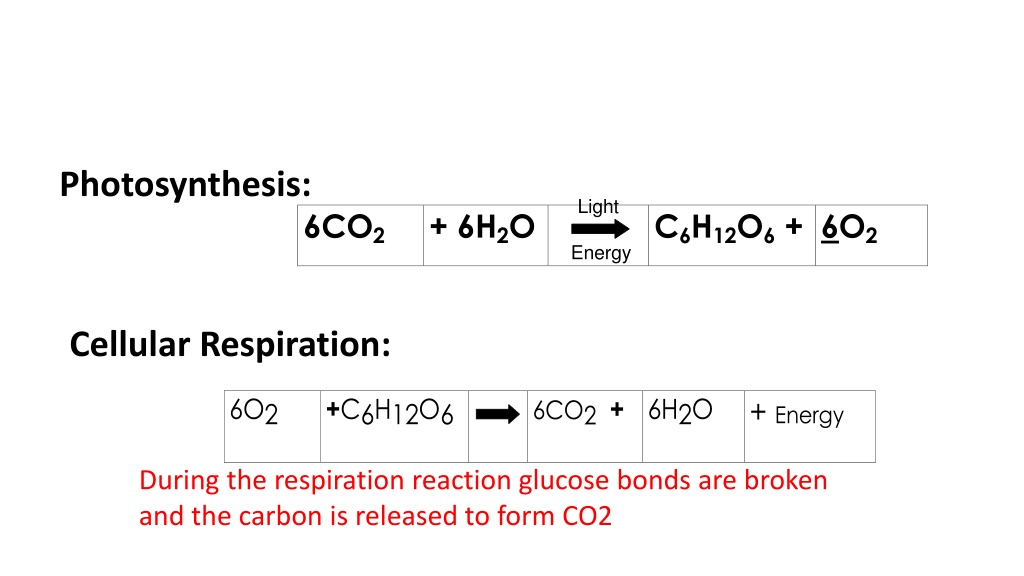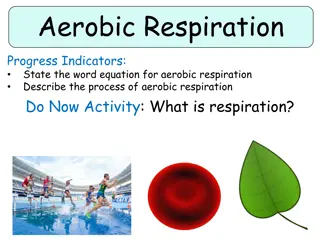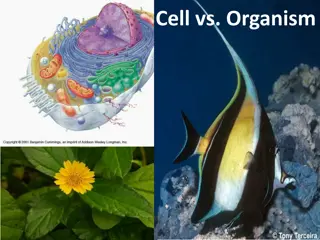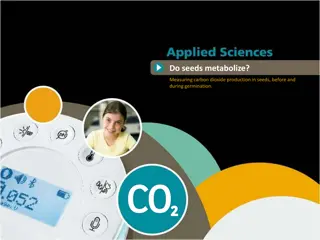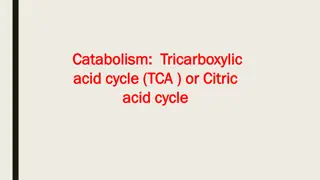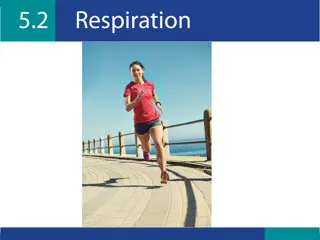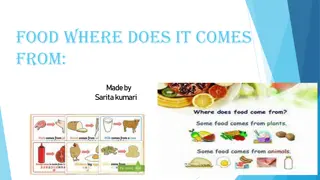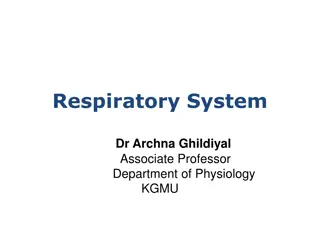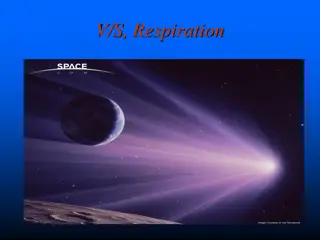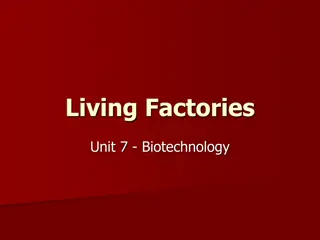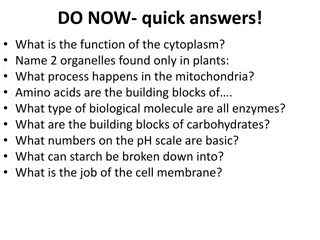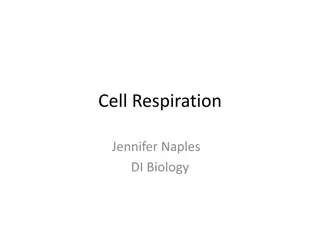Understanding Cellular Respiration in Plants and Animals
Explore the intricate processes of photosynthesis and cellular respiration, uncovering how plants and animals utilize glucose, oxygen, and energy to sustain life. Discover the essential role of ATP production and the interdependent relationship between carbon dioxide and oxygen in the environment.
Download Presentation

Please find below an Image/Link to download the presentation.
The content on the website is provided AS IS for your information and personal use only. It may not be sold, licensed, or shared on other websites without obtaining consent from the author. Download presentation by click this link. If you encounter any issues during the download, it is possible that the publisher has removed the file from their server.
E N D
Presentation Transcript
Photosynthesis: Light 6CO2 + 6H2O C6H12O6 + 6O2 Energy Cellular Respiration: 6CO2 +6H2O + Energy 6O2 +C6H12O6 During the respiration reaction glucose bonds are broken and the carbon is released to form CO2
Cellular Respiration Notes (Use the NAMES of the molecules) According to your equation, the process of cellular respiration uses ____________________ and ___________________ to produce ________________________, ___________________ and release ____________________. _______ + ____ ____ + _____ + _____ Glucose Carbon Dioxide ATP (energy) Oxygen Water
Cellular Respiration Notes In cellular respiration, chemical energy is released from ____________ molecules and transferred to ____________ molecules, which cells can use to provide energy for cellular processes. Glucose ATP Cellular respiration occurs in both plants and animals. Given what you know about animals, why does your position for CO2 and O2in the equation make sense? Because it is a give and take relationship we give plants CO2 and plants give us O2
Cellular Respiration Notes Interpret the chemical reaction - what is the overall purpose of cellular respiration? The purpose of the chemical reaction is to break down glucose that we get from our food and use oxygen that we inhale to produce and release carbon dioxide and ATP (energy) for us to carry out cellular processes. What are the two main differences between the chemical reaction for photosynthesis and the chemical reaction for cellular respiration? 1. The products and reactants are reversed 2. Cellular Respiration produces ATP energy, and Photosynthesis uses Sunlight energy.
Two types 1. Aerobic used when there is enough oxygen (makes the most ATP) Steps a. Glycolysis b. Krebs Cycle c. Electron Transport chain What cell in the body needs to complete cellular respiration the most?
Total Energy for Aerobic Gycolysis 2 ATP Krebs Cycle 2 ATP Electron Transport Chain 34 ATP - produces the most ATP Total = 38 ATP
6H2O 6CO2 C6H12O6 6O2 Sunlight C6H12O6 6O2 6CO2 6H2O ATP
Process only occurs in plant cells Reactants include o2 New molecules include CO2 and H2O Reactant include CO2 Process occurs in plants and animals Reactant include H2O ATP provides energy for cellular processes Process occurs in a chloroplast ATP is produced during glycolysis New molecules include O2 Process occurs in a mitochondria New molecules include C6H12O6 Reactants include C6H12O6 Process occurs during the daylight Process occurs during the day light or dark
Practice, Practice, Practice Practice, Practice, Practice Teach your partner the difference between Cellular Respiration and Photosynthesis. Explain to them: 1. What are the reactants and products write and say the chemical formula including how many of each molecule you need? 2. Where or how do they enter the plant or animal? 3. Where in the plant/animal cell does each process takes place. 4. What type of organisms can undergo each process? 5. Two main differences of photosynthesis and cellular respiration are
1. What are the reactants and products write and say the chemical formula including how many of each molecule you need? 2. Where or how do they enter/leave the plant or animal? Photosynthesis: carbon dioxide enters the stoma, water enters the stem from the xylem, sunlight enters the top of leaves, glucose is transported throughout the plant through the phloem, and oxygen exits through the stoma. Cellular Respiration: glucose comes from the foods that we consume, oxygen enters our cells from the lungs by diffusion, carbon dioxide exits our cells into our lungs by diffusion, and water exits out bodies in the form of urine and sweat. 3. Where in the plant/animal cell does each process takes place. Photosynthesis takes place in the leaves of plants choloroplast Cellular Respiration takes place in the cytoplasm and mitochondria 4. What type of organisms can undergo each process? Photosynthesis plants and plant like organisms only Cellular Respiration: Plants and Animals 5. Two main differences of photosynthesis and cellular respiration are 1. The Reactants and Products are reversed in the chemical formula/equation. 2. The type of energy they use are different: Photosynthesis uses light energy from the sun , and Cellular Respiration uses ATP energy .
Question with your group Explain the roles of chloroplasts and mitochondria in cellular respiration and photosynthesis. Be specific in their functions and types of cells.
Answer to questions with group Photosynthesis: uses the Chloroplast (plant cells only) to make glucose (high energy sugar) and oxygen - Cellular Respiration: use the Mitochondria (animal and plants cells) to make carbon dioxide, water, and ATP (energy)
